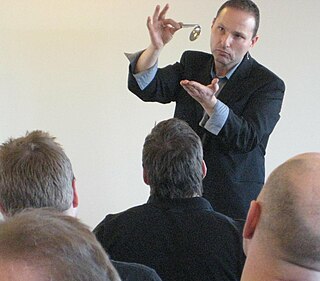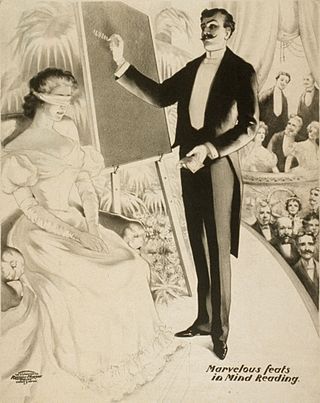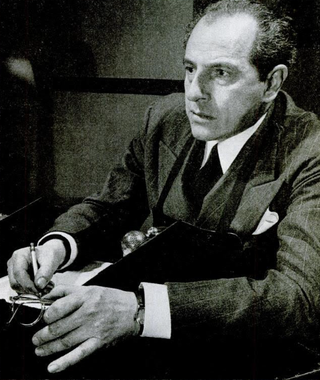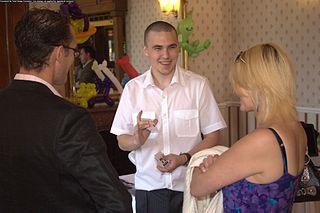Related Research Articles

Derren Brown is an English mentalist, illusionist, painter, and author. He began performing in 1992, making his television debut with Derren Brown: Mind Control in 2000, and has since produced several more shows for stage and television. His 2006 show Something Wicked This Way Comes and his 2012 show Svengali won him two Laurence Olivier Awards for Best Entertainment. He made his Broadway debut with his 2019 stage show Secret. He has also written books for both magicians and the general public.

The cups and balls is a performance of magic with innumerable adaptations. Street gambling variations performed by conmen were known as Bunco Booths. A typical cups and balls routine includes many of the most fundamental effects of magic: the balls can vanish, appear, transpose, reappear and transform. Basic skills, such as misdirection, manual dexterity, sleight of hand, and audience management are also essential to most cups and balls routines. As a result, mastery of the cups and balls is considered by many as the litmus test of a magician's skill with gimmick style tricks. Magician John Mulholland wrote that Harry Houdini had expressed the opinion that no one could be considered an accomplished magician until he had mastered the cups and balls. Professor Hoffman called the cups and balls "the groundwork of all legerdemain".
Sleight of hand refers to fine motor skills when used by performing artists in different art forms to entertain or manipulate. It is closely associated with close-up magic, card magic, card flourishing and stealing. Because of its heavy use and practice by magicians, sleight of hand is often confused as a branch of magic; however, it is a separate genre of entertainment and many artists practice sleight of hand as an independent skill. Sleight of hand pioneers with worldwide acclaim include Dan and Dave, Ricky Jay, Derek DelGaudio, David Copperfield, Yann Frisch, Norbert Ferré, Dai Vernon, Cardini, Tony Slydini, Helder Guimarães and Tom Mullica.

In theatrical magic, misdirection is a form of deception in which the performer draws audience attention to one thing to distract it from another. Managing audience attention is the aim of all theater, and the foremost requirement of all magic acts. Whether the magic is of a "pocket trick" variety or a large stage production, misdirection is the central secret. The term describes either the effect or the sleight of hand or patter that creates it.

Coin magic is the manipulating of coins to entertain audiences. Because coins are small, most coin tricks are considered close-up magic or table magic, as the audience must be close to the performer to see the effects. Though stage conjurers generally do not use coin effects, coin magic is sometimes performed onstage using large coins. In a different type of performance setting, a close-up coin magician will use a large video projector so the audience can see the magic on a big screen. Coin magic is generally considered harder to master than other close-up techniques such as card magic, as it requires great skill and grace to perform convincingly, and this requires much practice to acquire.

Spoon bending is the deformation of objects, especially metal cutlery, purportedly by paranormal means. It is a common theme for magic tricks, which use a variety of methods to produce the effect. Performers commonly use misdirection to draw their audience's attention away while the spoon is manually bent. Another method uses a metal spoon that has been prepared by repeatedly bending the spoon back and forth, weakening the material. Applying light pressure will then cause it to bend or break.

Mentalism is a performing art in which its practitioners, known as mentalists, appear to demonstrate highly developed mental or intuitive abilities. Performances may appear to include hypnosis, telepathy, clairvoyance, divination, precognition, psychokinesis, mediumship, mind control, memory feats, deduction, and rapid mathematics. Mentalists perform a theatrical act that includes special effects that may appear to employ psychic or supernatural forces but that are actually achieved by "ordinary conjuring means", natural human abilities, and an in-depth understanding of key principles from human psychology or other behavioral sciences.

Tony Slydini, simply known as Slydini, was a world-renowned magician. His mastery, expertise, originality and innovative approach to close-up artistry magic, earned him a legendary reputation in the magic world. He traveled the world performing for the public as well as performing and lecturing fellow magicians. As a result, he served as an inspiration to generations of well-known magicians, celebrities and entertainers, including Doug Henning, Dick Cavett, Bill Bixby, Ricky Jay, David Copperfield and countless others. Although he was best known as a master of close-up artistry, he continually demonstrated an extraordinary performing ability and during his lifetime was responsible for a long series of books, films and publications highlighting his mastery of the magical crafts. For his work, he received the highest honors that his profession could bestow, including both the coveted Masters Fellowship Award and Performing Fellowship Award from the Academy of Magical Arts. During his lifetime, Tony Slydini was inducted into the Society of American Magicians Hall of Fame as a Living Legend.
The Indian rope trick is a magic trick said to have been performed in and around India during the 19th century. Sometimes described as "the world’s greatest illusion", it reputedly involved a magician, a length of rope, and one or more boy assistants.

The Prestige is a 1995 fantasy novel by British writer Christopher Priest. It tells the story of a prolonged feud between two stage magicians in late 1800s England. Its structure is that of a collection of diaries that were kept by the protagonists and later collated. The title derives from the novel's fictional practice of stage illusions having three parts: the setup, the performance, and the prestige (effect).
This is a glossary of conjuring terms used by magicians.

Muscle reading, also known as "Hellstromism", "Cumberlandism" or "contact mind reading", is a technique used by mentalists to determine the thoughts or knowledge of a subject, the effect of which tends to be perceived as a form of mind reading. The performer can determine many things about the mental state of a subject by observing subtle, involuntary responses to speech or any other stimuli. It is closely related to the ideomotor effect, whereby subtle movements made without conscious awareness reflect a physical movement, action or direction which the subject is thinking about. The term "muscle reading" was coined in the 1870s by American neurologist George M. Beard to describe the actions of mentalist J. Randall Brown, an early proponent of the art.

Joseph Dunninger, known as "The Amazing Dunninger", was one of the most famous and proficient mentalists of all time. He was one of the pioneer performers of magic on radio and television. A debunker of fraudulent mediums, Dunninger claimed to replicate through trickery all spiritualist phenomena.

The hat-trick is a classic magic trick where a performer will produce an object out of an apparently empty top hat.
Servantes are theatrical properties or "props" used by magicians. Their purpose is to assist the magician to misdirect the audience by storing and concealing items, such as playing cards, cups, or balls. The term "servante" comes from the French for "dumbwaiter."

Mark Wilson's Complete Course in Magic is a book on magic written by magician Mark Wilson. The book is a popular reference for magicians and has been in print since its first issue in 1975.

Close-up magic is magic performed in an intimate setting usually no more than 3 meters from one's audience and is usually performed while sitting at a table.

Children's magic is a specialized aspect of parlor magic and is meant to entertain children. It is typically performed at birthday parties, churches, preschools, elementary schools, Sunday Schools or libraries. It is often the only type of magic most Westerners experience other than that seen on television. This type of magic is usually comedic in nature.

Chink-a-chink is a simple close-up magic coin trick in which a variety of small objects, usually four, appear to magically transport themselves from location to location when covered by the performer's hands, until the items end up gathered together in the same place. Variations, especially the Sympathetic Coins also known as Coins-n-Cards, have been performed since the 1800s. Popular modern variations are Shadow Coins and Matrix. A variation using playing cards as the objects is known as Sympathetic Aces.

Magic, which encompasses the subgenres of illusion, stage magic, and close-up magic, among others, is a performing art in which audiences are entertained by tricks, effects, or illusions of seemingly impossible feats, using natural means. It is to be distinguished from paranormal magic which are effects claimed to be created through supernatural means. It is one of the oldest performing arts in the world.
References
- ↑ "Sleeving Secrets Revealed". Magic Tricks Incorporated. Retrieved 8 October 2013.
- ↑ "Lapping". Life Tips. Retrieved 8 October 2013.
- ↑ "How to do magic tricks #8: Tony Slydini – The Master of Misdirection". How to do Magic Trick Corner. Retrieved 8 September 2013.